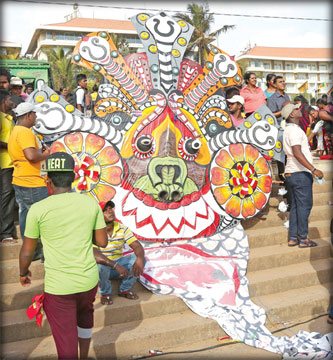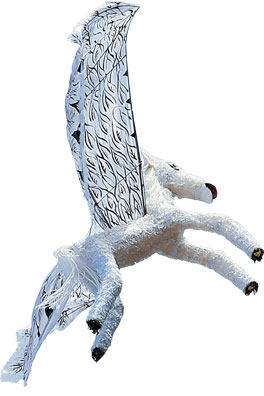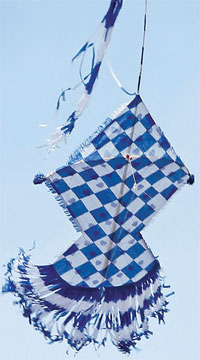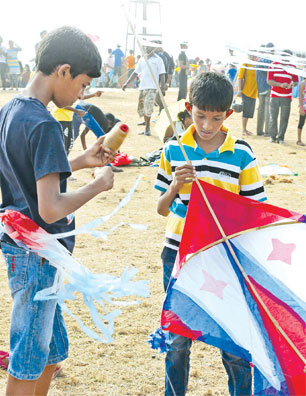Colour, fun, soaring high
By Kishani Samaraweera
 As the winds of the South West Monsoon blow across our island, the
month of August is known as ‘The Season’ for kite flying. It is probably
the favourite month of both kite enthusiasts and kite sellers. Several
kite festivals are being held annually in the country and thousands of
kite lovers participate with great enthusiasm. Named as a leisure
activity, kite flying is not limited to any age limit. It is in fact a
part of everyday life. As the winds of the South West Monsoon blow across our island, the
month of August is known as ‘The Season’ for kite flying. It is probably
the favourite month of both kite enthusiasts and kite sellers. Several
kite festivals are being held annually in the country and thousands of
kite lovers participate with great enthusiasm. Named as a leisure
activity, kite flying is not limited to any age limit. It is in fact a
part of everyday life.
Origins
 It is believed that the kites were invented in China roughly 2,800
years ago. Initially they have used silk material and bamboo which is
resilient, to build the frame since they were readily available. The
first kites were of the shape of a rectangular. They were flat and
decorated with mythological motifs and legendary figures. Around the
world, kite festivals are a tradition especially in India and in
European countries like Greece and Cyprus. In Sri Lanka also several
kite festivals and events are being held all around the island, usually
during the month of August. It is believed that the kites were invented in China roughly 2,800
years ago. Initially they have used silk material and bamboo which is
resilient, to build the frame since they were readily available. The
first kites were of the shape of a rectangular. They were flat and
decorated with mythological motifs and legendary figures. Around the
world, kite festivals are a tradition especially in India and in
European countries like Greece and Cyprus. In Sri Lanka also several
kite festivals and events are being held all around the island, usually
during the month of August.
Varieties and prices
The colourful kites are in different shapes. Each and every kite is
unique in colour, designs, and size. Some are massive. They are in the
shape of dragons, snakes, butterflies and all types of animals and birds
priced from Rs.150 upwards. One particularly interesting one that caught
my eye was of a sheep. (It won’t be long before somebody makes one of a
flying human!)
Some kites are imported ones, which are made out of clothes with
different designs and the others are simple, handmade kites. The price
range is from Rs. 150 to 500. The designs of the kites and the
techniques have evolved with the time. Now they have kites which are
more modern and has LED lights fixed to it.
 “We prepare kites with LED light only when we get orders and it
usually costs Rs.700. We make those with tissue paper (oiled paper) and
bamboo which are traditional materials”, says Ganga, who has been
selling kites and other items at the Galle Face Green for over 15 years. “We prepare kites with LED light only when we get orders and it
usually costs Rs.700. We make those with tissue paper (oiled paper) and
bamboo which are traditional materials”, says Ganga, who has been
selling kites and other items at the Galle Face Green for over 15 years.
 Explaining that not every day is profitable, she admitted that during
the month of August, they can earn up to Rs.10, 000 per day. According
to Ganga they also get a fairly good income during Vesak and school
holidays as well. Explaining that not every day is profitable, she admitted that during
the month of August, they can earn up to Rs.10, 000 per day. According
to Ganga they also get a fairly good income during Vesak and school
holidays as well.
Ideal sites
By this time of the year, harvesting is done and the paddy fields
make ideal places for flying kites. Also perfect wind condition for kite
flying is found in August. Especially since it is the school vacation, a
lot of school kids are busy making kites and competing with each others’
kites. In some areas they organize small competitions as well.
In Colombo, the most popular and ideal site to fly kites is the Galle
Face Green. After the sun goes down, the sky above Galle Face is filled
with colourful kites. Given the spacious setting, it has become a
paradise for the kite lovers. Thousands of kites flying up in the skies
of The Galle Face Green are a very common sight in any day of the week.
It does not necessarily have to be “The Season.”
Kite Festivals
The first ever National Kite Festival was held in 2009 in Negombo and
the next was held in 2010 in Matara. Kite festivals give opportunity for
kite enthusiasts and also for international competitors.
 These festivals aims to provide a platform for thousands of local and
foreign kite lovers from all age groups, ethnicities and economic
backgrounds to enjoy kite flying. The organisers of kite festivals too
have actively participated in a number of international kite festivals. These festivals aims to provide a platform for thousands of local and
foreign kite lovers from all age groups, ethnicities and economic
backgrounds to enjoy kite flying. The organisers of kite festivals too
have actively participated in a number of international kite festivals.
The festivals, especially The National Kite Festival is established
to popularize kite-flying as a sport and they also intend promote Sri
Lankan culture, arts, traditions and national heredity.
Safety
There are certain safety issues when it comes to kite-flying. The
strings can tangle on electrical power lines. Recently a 14-year-old
student died after getting electrocuted when the kite he was flying with
copper fiber-mixed-string came into contact with a high voltage
electrical cable.
Also kites with a large surface area or powerful lift can pull
kite-fliers off the ground or drag them into other objects. Wet kite
lines are also dangerous since those can result in electrocuting the
kite-flier, especially in adverse weather conditions such as lightening
and in stormy weather. |

